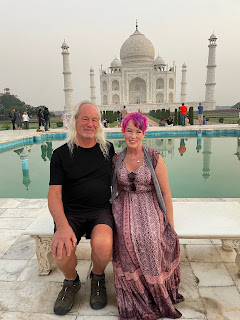Last week's blog was posted from India. This week's blog comes to you from Kathmandu, and what a beautiful place it is too. A mere two hours’ flight from Delhi, yet a world apart. The India leg of our trip was brilliant, even if you were reminded every moment of every day of the contrast between the lives of the rich and the poor. More of which later.
I have been to India before, but only on work business, presenting at conferences and so on. Despite perceptions to the contrary, this usually meant flying in, staying in a hotel, presenting a paper in a conference hall, with maybe just a day or two of sightseeing. So for this trip I was determined that J and I would do all the tourist bits, and more, so we hired a guide for our stay and did just that. And there was so much to see. We chose to do the Golden Triangle – Delhi, Jaipur, Agra and back to Delhi. This meant we were able to take in many of the sights India is famous for including The Palace of the Winds, The Am(b)er Fort, Fatehpur Sikri, Agra Fort, Jantar Mantar Observatory (one of my favourites), the Palace of the Maharaja and of course the Taj Mahal.
We had to get up at 04.00 to visit the Taj Mahal, and even then, we had about 40 people in front of us while we waited for the 06.00 opening time. It was worth the early morning start and the wait. The Taj Mahal is everything you expect it to be. J and I got to sit on the famous Princess Diana bench for the ubiquitous photo (it had to be done). We watched the sunrise and stood in awe as the Taj Mahal was revealed in all its glory. The whole site is some 17 hectares in size and yet it was all proportionate, symmetrical and stunning. It took 20,000 men 22 years to complete during the 17th century. To put this feat into perspective, the Grand Mosque in Abu Dhabi took 3,000 men 13 years to construct in the 20th century, and that is with all the benefits of modern construction techniques, materials and machinery.
I can now say that I have been to both places. They are both wonderful, but I think I preferred the Taj Mahal of the two and can absolutely see why it is now a UNESCO World Heritage site and still one of the seven wonders of the world.
What wasn’t so wonderful was the traffic. It was unbelievable, terrifying, literally death defying and the noise, a constant cacophony of horn blowing. Drivers constantly jostled for position; an inch gained was a reason for celebration, more horn blowing. However, in the whole time we were there, and we covered many miles, we did not witness one collision, or accident. It was simply remarkable. As was crossing the roads on foot. You had to take your courage in both hands and step out into the face of oncoming traffic and resolutely keep walking. The first time I did it my heart was in my mouth, and I had this fearful thought that someone would knock me down.
As you are reading this week’s blog, clearly that didn’t happen. I survived. Possibly it is just as well I wasn’t involved in an accident, as no-one takes any notice of the emergency vehicles even with their ‘blues and twos’ going. It’s just more noise to add to the general melee, and they have to fight for that all important inch forward like everyone else. The traffic was also a window into the wider inequalities across Indian society. There was everything from Range Rovers to rickety bicycles and everything you could possibly imagine as a form of transport, including camels, elephants, oxen and horses, in-between.
I found it very difficult to get information on the average income here, so don’t want to quote figures that might be widely wrong. However, doctors are paid considerably more than nurses, and like in the UK, the cost-of-living crisis appears to have hit India – see here. I did discover though that for every 100 rupees paid to a man, women were paid 112 rupees for the same role. What is difficult to understand is why so many families chose not to take advantage of the many government services that are provided free. There are fantastic education services available, free of charge, and where everything from school uniforms, school meals and bus pick ups are included, yet many families choose not to send their children to school, with the inevitable consequences for the child in terms of life chances.
Normal service resumes and hopefully the changeable font situation will be resolved. Next week's blog will come just North of Blackpool.


No comments:
Post a Comment